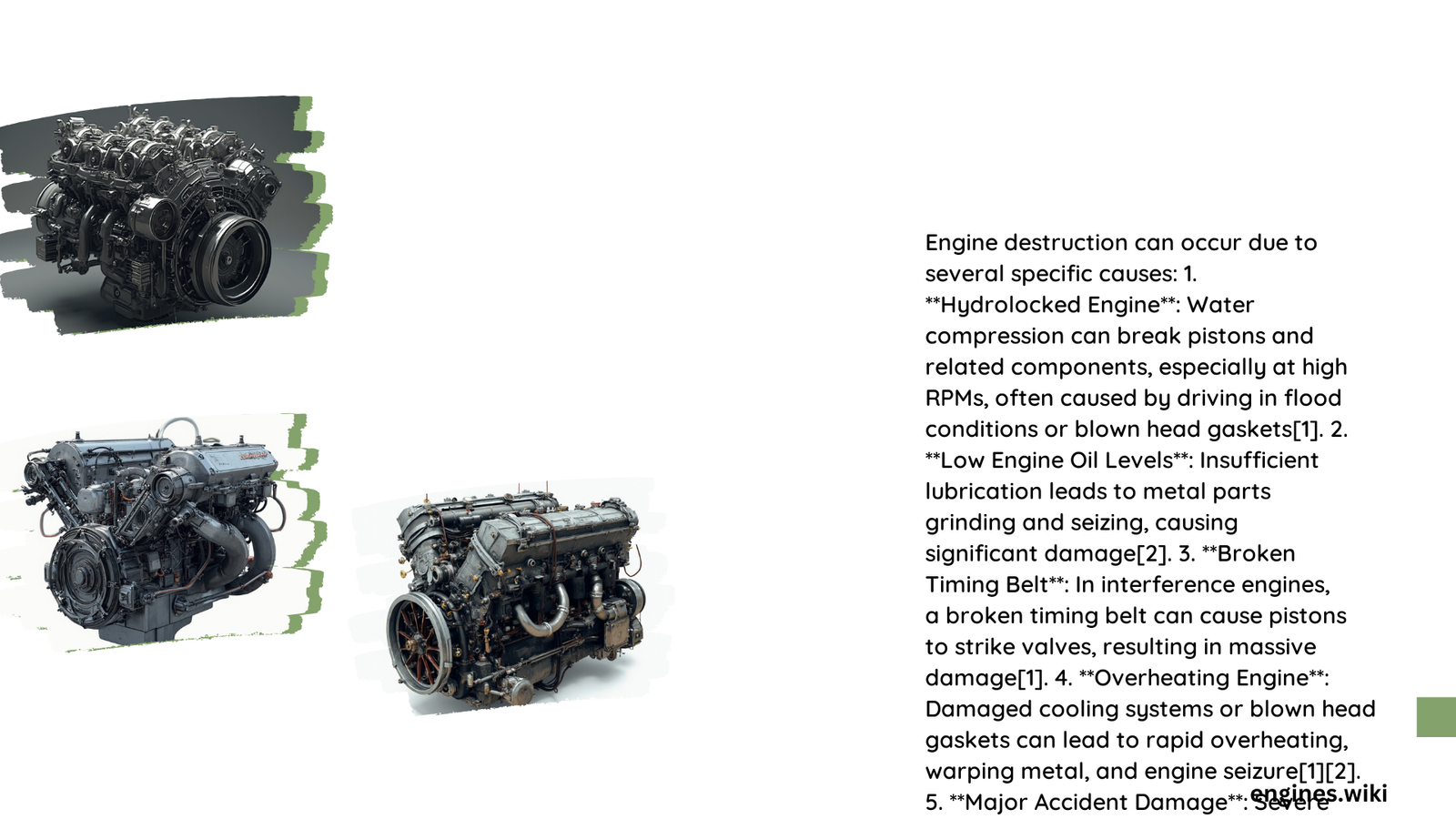Engine destruction is a catastrophic failure of a vehicle’s power plant, often resulting from severe mechanical issues, neglect, or extreme operating conditions. This comprehensive guide explores the primary causes of engine destruction, warning signs, and preventive measures to help vehicle owners avoid costly repairs and extend their engine’s lifespan.
What Are the Primary Causes of Engine Destruction?
Engine destruction can occur due to various factors, often stemming from neglect or improper maintenance. Here are the main culprits:
- Overheating
- Low oil levels
- Broken timing belt
- Hydrolocked engine
- Detonation
1. Overheating
Overheating is a critical cause of engine damage. When the cooling system fails, engine temperatures can soar, leading to:
- Warped cylinder heads
- Blown head gaskets
- Melted pistons
Prevention:
– Regularly check coolant levels
– Address any leaks promptly
– Monitor temperature gauge while driving
2. Low Oil Levels
Insufficient oil can cause severe friction between moving parts, resulting in:
- Seized engines
- Damaged bearings
- Scored cylinder walls
Prevention:
– Check oil levels regularly
– Follow manufacturer-recommended oil change intervals
– Address any oil leaks immediately
3. Broken Timing Belt
In interference engines, a broken timing belt can cause pistons to collide with valves, leading to catastrophic damage.
Prevention:
– Replace timing belt according to manufacturer’s schedule
– Listen for unusual noises from the timing belt area
4. Hydrolocked Engine
Water entering the combustion chamber can cause hydrolock, potentially bending connecting rods or cracking the engine block.
Prevention:
– Avoid driving through deep water
– Ensure proper sealing of air intake system
5. Detonation
Abnormal combustion can cause high cylinder pressures, damaging pistons, rings, and head gaskets.
Prevention:
– Use recommended fuel octane
– Address overheating issues promptly
– Maintain proper ignition timing
What Are the Warning Signs of Impending Engine Destruction?

Recognizing early symptoms can help prevent catastrophic engine failure. Look out for:
- Unusual noises (knocking, ticking)
- Excessive exhaust smoke
- Decreased performance
- Oil pressure warning light
- Check engine light
Unusual Noises
| Noise Type | Possible Cause |
|---|---|
| Knocking | Low oil, worn bearings |
| Ticking | Low oil pressure, valve train issues |
| Rattling | Loose components, timing chain wear |
Exhaust Smoke Colors
- Blue: Oil burning (worn piston rings or valve seals)
- White: Coolant leak (blown head gasket)
- Black: Rich fuel mixture (faulty fuel injectors or sensors)
How Can Engine Destruction Be Prevented?
Preventing engine destruction involves regular maintenance and attentive driving habits:
- Follow Maintenance Schedule: Adhere to manufacturer-recommended service intervals.
- Monitor Fluid Levels: Regularly check oil, coolant, and other vital fluids.
- Address Issues Promptly: Don’t ignore warning lights or unusual symptoms.
- Use Quality Parts: Invest in high-quality replacement parts and fluids.
- Drive Responsibly: Avoid aggressive driving and allow proper warm-up time.
Maintenance Checklist
- [ ] Oil changes every 5,000-7,500 miles
- [ ] Coolant flush every 30,000 miles
- [ ] Timing belt replacement (if applicable) every 60,000-100,000 miles
- [ ] Air filter replacement every 15,000-30,000 miles
- [ ] Spark plug replacement every 30,000-100,000 miles (depending on type)
What Are the Cost Implications of Engine Destruction?
Engine destruction can lead to significant financial burdens:
- Minor Repairs: $500 – $2,000
- Major Overhaul: $2,500 – $4,000
- Engine Replacement: $4,000 – $10,000+
Investing in regular maintenance is far more cost-effective than dealing with catastrophic engine failure.
How Does Engine Wear Affect Vehicle Performance?
Engine wear gradually impacts vehicle performance:
- Decreased Fuel Efficiency: Worn components reduce combustion efficiency.
- Power Loss: Compression loss leads to reduced horsepower and torque.
- Increased Emissions: Worn engines may fail emissions tests.
- Rough Idling: Uneven compression or ignition issues cause vibrations.
- Oil Consumption: Worn piston rings or valve seals increase oil burn.
Conclusion
Engine destruction is a severe and costly issue that can be largely prevented through diligent maintenance and attentive driving. By understanding the causes, recognizing warning signs, and following proper maintenance procedures, vehicle owners can significantly extend their engine’s lifespan and avoid the financial burden of catastrophic failure.
Remember, the key to preventing engine destruction lies in regular check-ups, timely repairs, and addressing issues before they escalate. Your engine is the heart of your vehicle – treat it with care, and it will serve you well for years to come.
